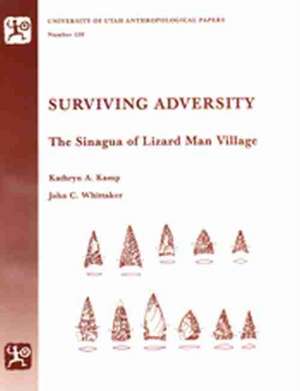Surviving Adversity - AP 120: University of Utah Anthropological Paper, cartea 120
Autor Kathryn Kamp, John C. Whittakeren Limba Engleză Paperback – dec 1998 – vârsta până la 80 ani
Based on more than ten years of field work, this is the only modern interpretive site report on the Sinagua culture.
Lizard Man Village is one of many small settlements in the Flagstaff vicinity occupied by the Sinagua between AD 1050 and 1300. Generally considered affiliated with the Mogollon, the major archaeological culture group in central Arizona, the Sinagua inhabited a region where three distinct groups intersected: the Mogollon, the Hohokam, and the Anasazi.
Sinagua survival strategy in this very arid region combined dispersed agriculture with hunting and foraging. It appears that an essentially egalitarian social system allowed flexibility to maximize wild resources and potential agricultural sites or vice versa. The area is characterized by a number of small villages that probably consisted of only a few families each. Precisely because Lizard Man Village is typical of such sites, the authors chose it for intensive fieldwork. According to them, "in its very ordinariness lies its importance."
Based on the site report, the authors provide interpretations for comparison to other sites in the Southwest, as well as a detailed consideration of what went on at a small Sinagua village. Using material assemblages they present a picture of social organization through successive culture phases.
Lizard Man Village is one of many small settlements in the Flagstaff vicinity occupied by the Sinagua between AD 1050 and 1300. Generally considered affiliated with the Mogollon, the major archaeological culture group in central Arizona, the Sinagua inhabited a region where three distinct groups intersected: the Mogollon, the Hohokam, and the Anasazi.
Sinagua survival strategy in this very arid region combined dispersed agriculture with hunting and foraging. It appears that an essentially egalitarian social system allowed flexibility to maximize wild resources and potential agricultural sites or vice versa. The area is characterized by a number of small villages that probably consisted of only a few families each. Precisely because Lizard Man Village is typical of such sites, the authors chose it for intensive fieldwork. According to them, "in its very ordinariness lies its importance."
Based on the site report, the authors provide interpretations for comparison to other sites in the Southwest, as well as a detailed consideration of what went on at a small Sinagua village. Using material assemblages they present a picture of social organization through successive culture phases.
Preț: 268.74 lei
Preț vechi: 324.94 lei
-17% Nou
Puncte Express: 403
Preț estimativ în valută:
51.43€ • 52.67$ • 42.78£
51.43€ • 52.67$ • 42.78£
Carte indisponibilă temporar
Doresc să fiu notificat când acest titlu va fi disponibil:
Se trimite...
Preluare comenzi: 021 569.72.76
Specificații
ISBN-13: 9780874805758
ISBN-10: 0874805759
Pagini: 224
Ilustrații: 97 figures, 96 tables
Dimensiuni: 216 x 279 x 13 mm
Greutate: 0.61 kg
Ediția:1st Edition
Editura: University of Utah Press
Colecția University of Utah Press
Seria University of Utah Anthropological Paper
ISBN-10: 0874805759
Pagini: 224
Ilustrații: 97 figures, 96 tables
Dimensiuni: 216 x 279 x 13 mm
Greutate: 0.61 kg
Ediția:1st Edition
Editura: University of Utah Press
Colecția University of Utah Press
Seria University of Utah Anthropological Paper
Notă biografică
Kathryn Kamp and John Whittaker are associate professors in the Department of Anthropology at Grinnell College.












